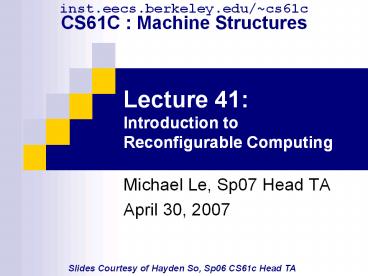Lecture%2041:%20Introduction%20to%20Reconfigurable%20Computing - PowerPoint PPT Presentation
Title:
Lecture%2041:%20Introduction%20to%20Reconfigurable%20Computing
Description:
... Hayden So, Sp06 CS61c Head TA. Following the tech news tradition... http://news.yahoo.com/s/ap/20070430/ap_on_hi_te/mind_reading_toys. Outline. Computing... – PowerPoint PPT presentation
Number of Views:82
Avg rating:3.0/5.0
Title: Lecture%2041:%20Introduction%20to%20Reconfigurable%20Computing
1
Lecture 41 Introduction to Reconfigurable
Computing
inst.eecs.berkeley.edu/cs61c CS61C Machine
Structures
- Michael Le, Sp07 Head TA
- April 30, 2007
Slides Courtesy of Hayden So, Sp06 CS61c Head TA
2
Following the tech news tradition
- NeuroSky of San Jose, CA aims to add more
realistic elements to video games by using brain
wave-reading technology to help game developers
make gaming more realistic.
http//news.yahoo.com/s/ap/20070430/ap_on_hi_te/mi
nd_reading_toys
3
Outline
- Computing What does it mean?
- Processor vs ASIC
- FPGA-based Reconfigurable Computing
- Real stuff
4
Back to basics
- What does the word computer mean to you?
- Your 700 box sitting under your desk at home?
- The 2000 laptop you are using to check email
right now? - The 5-stage pipeline processor?
5
Informal Definition
- A computer is a machine that computes
- add, subtract, logical operations, decisions
- What have we learned about computing in this
semester?
6
Calculating Class Grades
- grade 0.1 ? mt1 0.2 ? mt2
- 0.3 ? hw 0.4 ? proj
grade 0 tmp 0.1 ? mt1 grade grade
tmp tmp 0.2 ? mt2 grade grade tmp tmp
0.3 ? hw grade grade tmp tmp 0.4 ?
proj grade grade tmp
This is not how we are going to calculate your
grades
7
Computing Final Grade (2)
0.1
mt1
0.2
mt2
0.3
hw
0.4
proj
SPACE
8
2 Ways to Compute
TIME
9
Processor vs ASIC
- Take longer to compute
- slow
- Flexible
- Need instructions to determine what to do on each
cycle - Space is bounded
- Take shorter time to compute
- fast
- Not Flexible
- No instruction
- Same calculation every cycle
- Space unbounded
- Branches?
Temporal Computing
Spatial Computing
10
Visualizing Spatial Computing
- AMD Opteron 64-bit processor
- 1MB L2 Cache
- 193 mm sq
- 0.18 micron CMOS
- 89W _at_ 1.8GHz
- 3 Op / cycle (int op)
- Full Custom ASIC
- 4x4 Single Value Decomposition
- 3.5 mm sq
- 90nm CMOS
- 34mW _at_ 100 MHz clock
- 70 GOPS 700 Op / cycle
11
Between Temporal Spatial Computing
ASIC
Single Processor
?
Temporal
Spatial
Reconfigurable Computing
- Slow
- Flexible
- Fast
- Inflexible
12
Reconfigurable Computing
- No standard definition
- Computing via a post-fabrication and spatially
programmed connection of processing elements. - -John Wawrzynek Sp04
- A computer that can RE-configure itself to
perform computation spatially as needed - How often do we RE-configure?
- Coarse-grain? Fine-grain?
- Example FPGA
13
Introduction to the FPGA
- Field Programmable Gate Array
- Began as ASIC replacements
- ASIC that can be configured in the field
- At power up, configuration is loaded onto the
chip - Chip acts as an ASIC until power down
- Modern FPGA more like computers
- Exploit dynamic, partial reconfiguration
- Embedded processors
- Xilinx, Altera are 2 major market leaders
14
The LUT
- LUT Lookup Table
- A direct implementation of a truth table
- Recall a TT uniquely defines a circuit
- An n-LUT implements any n-input combinational
logic - Depends on LUT configuration
15
Making a 2-LUT from Truth Table
A B
0 0 0 1 1 0 1 1
16
2-LUT CL and MUX Based
cfg2
cfg0
cfg3
cfg1
Q
A
B
0 0 0 0 0 0 0 0 0 0 0 0 1 0 0 0 0 0 1 0 0 0 0
0 0 1 1 0 0 0 0 1 0 0 0 0 0 0 1 0 1 0 1 1 1 1
1 0 1 1 1 1 1 1 1 1
17
LUTs in Real Life
- 3-LUT and 4-LUT are most common
- SRAM based
- Learn, and use, them a lot in CS150
18
Sequential logic
- Connecting multiple LUTs gives us ANY
combinational logic we want to implement - We need Flip-Flop to build sequential circuits
- FF are so important that they are included
natively on FPGAs next to each LUT - LUT FF LB (Logic Block)
19
Logic Block
- Can build any 4-input circuit
- Synchronous OR Asynchronous
- Combining Logic Blocks gt ANY synchronous digital
circuit - How to we build bigger circuit?
20
Routing of FPGA
- With enough smartness in placement and routing,
we can implement any synchronous digital circuits!
21
Example Xilinx Virtex2pro xc2vp70
- 74,448 Logic Cells (LB)
- 2 PowerPC cores
- 328 18x18 bits multipliers
- 5904 Kbytes on chip memory
- 8 Digital Clock Managers
- 996 I/O pins
- 16 high speed serial I/O
- ports
22
Die Photo of a FPGA
Entire Chip is for Computation
Spartan-3 90nm CMOS
23
Real Stuff BEE2
- Developed at Berkeley
- Berkeley Wireless Research Center
- 5 Xilinx xc2vp70
- 40Gbytes DDR2 memory
- Used for research in
- Wireless
- Astro-Physics (SETI)
- Bioinformatics
- Speech Recognition
24
Conclusion
- The Processor is NOT the only way to do
computation - Reconfigurable computers allows different
tradeoffs among speed, flexibility, cost, power,
etc - FPGA offers fine-grain reconfigurability































